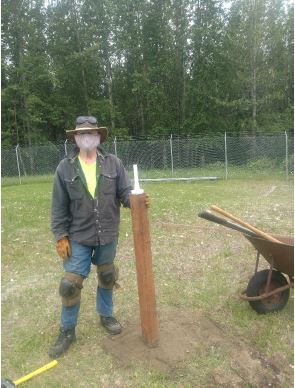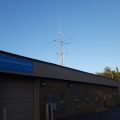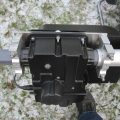Shared Apex Loop Receive Antenna Installed
TJ Sheffield KL7TS and I (Dave Webb N9AIG) started at about 10:00 AM working outside at the RSOC and followed social distancing rules. We both wore masks and gloves; when we had discussions, we made sure we were 10’ apart and had a crosswind. The real goal of the day was to erect the Shared Apex Loop Antenna. This is a receive-only antenna and is described on the Array Solutions website.
The antenna is a true-time-delay array with four identical wire loops supported by a single non-conductive mast. Signals from each loop are transferred through a ferrite coupler to a short-balanced line that connects to the switch/combiner/amp enclosure mounted at the base of the antenna. Within this enclosure, signals from each loop are routed either directly to a combiner or through a delay line and then to the combiner, where they are amplified by a dual stage balanced broadband amplifier and sent out to the feed line to the controller located in the shack. The controller connects directly to your receiver and sends power and control signals over the feed line to the antenna.
I would emphasize that this is a receive-only antenna. Even a momentary transmit signal will destroy the controller box. The plan is to connect this antenna to a receive-only port on the Elecraft transceiver.
TJ Sheffield KL7TS dug the center support post while I attached the insulated mast support to the 4”x4”x10’ long treated center post that would be direct buried into the hole. (I had the easier of the two jobs.) I was fully expecting to hear some discouraging words from TJ as he was performing the excavation, but none were uttered. It was quite unbelievable; no roots, hard clay or rocks the size of footballs. The material was all sand. (note: Rich Gillin AL4S had a similar experience when he dug the hole for the satellite tower.) We were both ready to go out and purchase some lottery tickets while our luck was good.

Next, TJ Sheffield KL7TS worked on the mast and antenna to get it ready for installation while I turned my attention to the inventory of batteries. I moved battery chargers around to continue to keep our batteries healthy. While inspecting the batteries, one of the Absolyte cells appears to have deteriorated to the point that it will have to be recycled (battery #7).
TJ Sheffield KL7TS was ready for the setting of the mast so we carried out the aluminum mast to the treated post. TJ was on a ladder by the post, and I pushed the mast toward him and pulled guy ropes to facilitate installation. Because of the thin aluminum mast, it was difficult to get the mast perfectly straight, but after a time, it improved when adjusting the guy ropes and antenna wires (which also act as guy supports).

It was a productive day with getting the new antenna installed and a few batteries charged.
Additional work includes optimizing the antenna for maximum front-to-back (F/B) ratio. The strategy is to use the portable Elecraft KX3 radio outside, about 100′ away from the mast. The antenna system uses RG-6 coax, with F-connectors, as a 75-ohm feed-line to the controller.
I left at about 4:00 PM and TJ continued to work on the final details of the antenna installation.
Dave N9AIG
AARC Secretary
July 8, 2020


